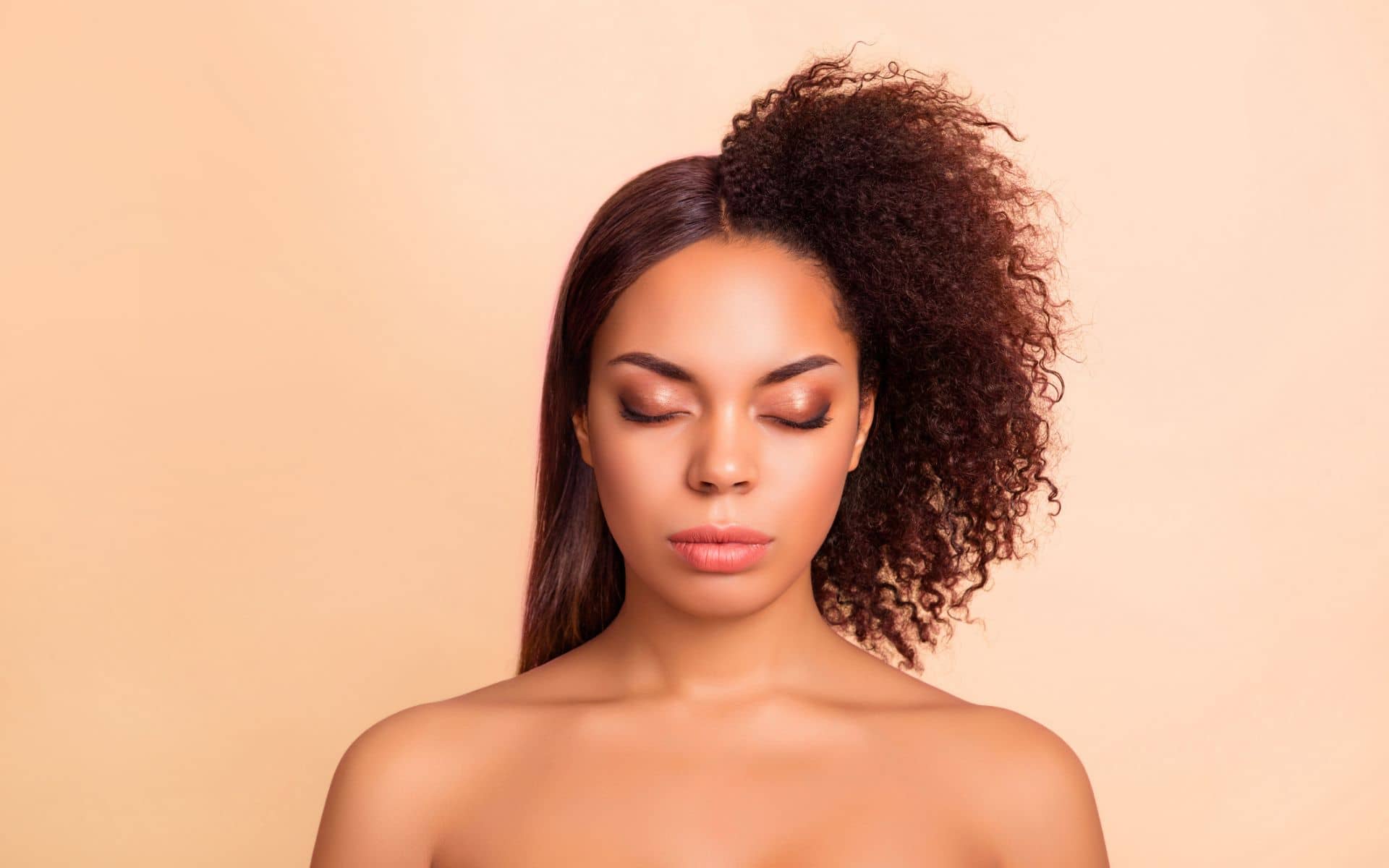Texture releases are becoming increasingly popular and being marketed to 3A – 4C naturals. The product aims to straighten your hair without damaging your coils/curls using heat, amino acids and conditioning agents. It straightens your natural hair without damaging your curls and coils but instead elongating them. With more and more naturals considering this as a solution for managing their natural hair. We thought it’s worthwhile discussing the pros, cons and things to consider before taking the plunge to get a texture release treatment.
So What is a Texture Release?
“Texture release is a heat activated smoothing system which uses amino acids and conditioning agents to penetrate deep into the hair fibres to straighten your hair. The product is specifically formulated for naturally curly hair and aims to change the texture of your hair strands whilst increasing the manageability of your hair.” 1
It’s similar to a relaxer to a certain degree because you’re altering your coil and curl pattern. The biggest difference is the chemicals in a texture release are significantly milder so you don’t experience burns, tingling or irritation. However, it’s important to note that although texture releases are marketed as non-damaging and a more natural alternative. The product still contains chemicals which can have an impact on your natural hair in the long term.
5 questions to ask yourself before getting a texture release
1. Do I want to alter my curl pattern?
Texture releases can alter your curl pattern by elongating them. So let’s say you’re a 4C natural, you could end up with a 4A or 4B curl pattern depending on how often and regularly you do a texture release. However there will be cases where you’ll end up with completely straight hair which doesn’t revert back so it’s important to bear that in mind. Especially if your hair is thin and fragile.
2. Do I like the versatility of my natural hair?
Although texture releases makes your hair more manageable and easier to style. You can get the same effect with a silk press and not have the problem of worrying if your hair will revert back. If you like the versatility of rocking your coils /curls and then switching it up for a straighter style then texture releases may not be the option for you. Try silk presses, blow out and roller sets instead.
3. Can I keep up with the maintenance treatments?
Texture releases last 8 to 12 weeks, in some cases you can stretch it slightly longer. You need to keep up with maintenance treatments which can be costly in the long run. You shouldn’t do a texture release at home by yourself and always go to a professional. So check out the costs and have a think about if it’s something you can actually keep up. Prices vary but in the US the average cost is around $275 dollars and £175 in the UK. You’ll also have to buy certain haircare products to maintain the style so bear that in mind when making decisions on the upkeep of the treatment.
4. Why did I stop relaxing my hair?
This is a key question to ask yourself and reflect on. Be honest with yourself about why you’re doing this! There are various reasons why people go Natural. It could be because of chemicals, wanting to embrace their natural hair, pain and discomfort of relaxers OR spending hours in the salon. The list goes on and everyone’s reason is different. If your key reason is to stay away from chemicals then texture releases might not be the option for you.
5. Am I willing to use chemicals on my hair and scalp?
Texture releases definitely aren’t in the same category as relaxers but it’s important to know you’ll be using some form of chemicals on your hair and scalp. Although the chemicals in a texture release aren’t as harsh as Sodium Hydroxide OR Lithium, Potassium, Calcium and Guanidine hydroxide. It’s still a chemical treatment which breaks down the bonds in your hair fibres and alters your curl pattern. The main ingredients in a texture release are “Glyoxylol Carbocysteine, Glyoxylol Keratin Amino Acids, and patent-pending Diamine.” 2
“Glyoxylic acid has emerged as a safe alternative to formol (formaldehyde) use as a hair straightener/relaxer. However, the possible damage to the hair fibre after its application is low known and/or published in the literature 3…The mechanism of action of glyoxylic acid does not appear to be based on breaking and rearrangement of disulfide bridges, but altered them and influenced the hair strength 4”
Intl Journal of Trichology & Intl Journal of Cosmetic Science
The study mentions more research needs to be carried out to understand the impact of the chemicals on your hair in the the long term. So decide if it’s a risk you’re willing to take – the biggest impact it’ll have on your hair is on its strength.
What are the benefits of texture release?
- Offers versatility with straighter hairstyles
- Last’s longer than a silk press
- Elongates your curls
- Reduces shrinkage
- Makes coarse and thick hair easier to maintain
- Great for those who are transitioning to natural
What are the cons of texture release?
- Must be done by a professional
- Maintenance can be costly over time
- Exposing your hair to heat and chemicals
- Risk of coils and curls not reverting back

FAQ’s
1: Does hair go back to normal after texture release?
Yes and No! Purley because you could have a slightly different experience to a fellow Naturalista. Lets delve into this into a bit more detail…
YES – The treatment washes out after several washes resulting in your hair reverting back to normal. Your coils and curls will not be exactly the same as pre-texture release but more elongated. This usually happens around the 3 month mark. Using a clarifying shampoo will ensure the treatment is completely removed from the hair.
NO – Many naturals have complained their coils and curls have remained completely straight despite washing out the treatment. Leading them to do a mini big chop and growing out their hair again due to damage. If your hair is thin and fragile then you risk your coils not reverting back.
To minimise damage to your coil and curl pattern, always go to a professional and read reviews beforehand. Explain any concerns you may have re; your hair reverting back and they’ll be able to advise you on products to use and how to maintain it.
2: Is texture release damaging?
As texture releases wash out over a period of time, your hair should revert back to normal. The treatment is designed not to cause any damage but temporarily alter your curl pattern. However, depending on your hair health, thickness, strength etc – you could end up with some damage. The bonds used in the product breaks down your curls which could affect the overall strength of your hair. If you currently have heat damage or recently dyed/bleached your hair then it’s recommended to wait a couple of months before getting the treatment.
3: Is texture release better than a relaxer?
Yes – It is much better. The chemicals used are significantly milder and not as harsh as chemicals found in relaxers. Texture releases mimic a texturizer to a certain degree but the benefit of the treatment is the product can be washed out after several washes. Some naturals who are transitioning might opt for a texture release to manage their 2 textures.
4: What chemicals are in a texture release?
The main ingredients in texture release are Glyoxylol Carbocysteine, Glyoxylol Keratin Amino Acids, and patent-pending Diamine. Glyoxylol Carbocysteine has a combination of glycoxylic acid, cysteine and acetic acid. Although Glycoxylic acid is classed as a safer form of formaldehyde. It may have an impact on your hair strength because of the curl altering process. As we mentioned earlier, there is limited research on the long term impact it can have on your hair and scalp but definitely deemed safer.
5: How to loosen your curl pattern without chemicals?
Depending on how you wear your hair on a daily basis. There are a couple ways you can elongate your curls specifically using stretching and banding techniques. It really depends on the style you’re trying to achieve. Watch the video below to understand how the techniques work.
Practise always makes perfect, so be patient with yourself and feel free to try other methods too.
FINAL THOUGHTS
When considering getting a texture release, it’s important to do what’s right for you and works for your hair care maintenance needs. Although this is a chemical enhancing treatment, it’s very mild in comparison to relaxers. Your curl pattern will be altered and elongated so weigh up the pros and cons before getting a texture release. Use the 5 questions to help you decide if this is something you should do or not do. At the end of the day, everyones hair and lifestyle is different so you have to make a decision that’ll add value to you as opposed to just following a trend.
We hope you found this article insightful and feel free to ask questions in the comment section. Although, were not experts we’ll be able to steer you in the right direction or share links that might help with your decision making process.
What to read next about straightening Natural Hair: 10 Silk Press Maintenance Tips
REFERENCES
- Avlon – Texture Release ↩︎
- Respect – Science of Texture Release ↩︎
- Velasco, Maria Valéria Robles et al. “Impact of Acid (“Progressive Brush”) and Alkaline Straightening on the Hair Fiber: Differential Effects on the Cuticle and Cortex Properties.” International journal of trichology vol. 14,6 (2022): 197-203. doi:10.4103/ijt.ijt_158_20 ↩︎
- Boga, Carla & Taddei, Paola & Micheletti, Gabriele & Ascari, Federico & Ballarin, Barbara & Morigi, Massimo & Galli, Sylvestre. (2014). Formaldehyde replacement with glyoxylic acid in semipermanent hair straightening: A new and multidisciplinary investigation. International Journal of Cosmetic Science. 36. 10.1111/ics.12148. ↩︎


































